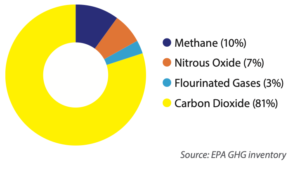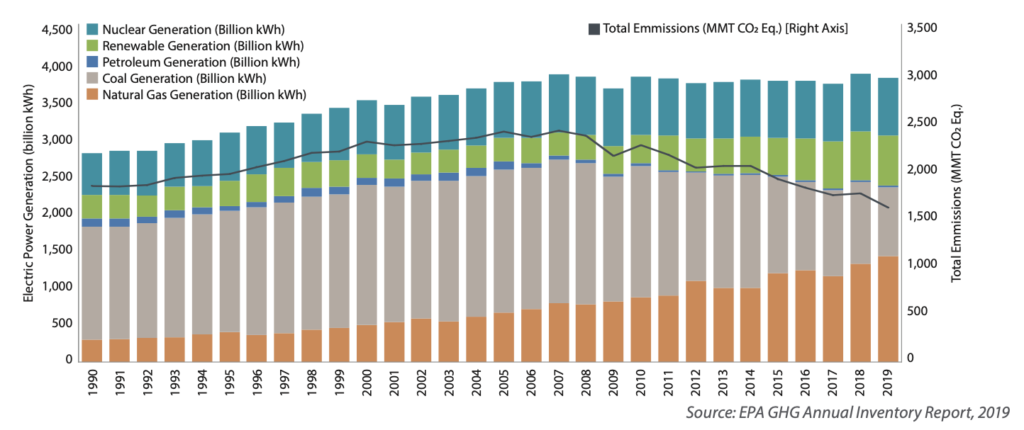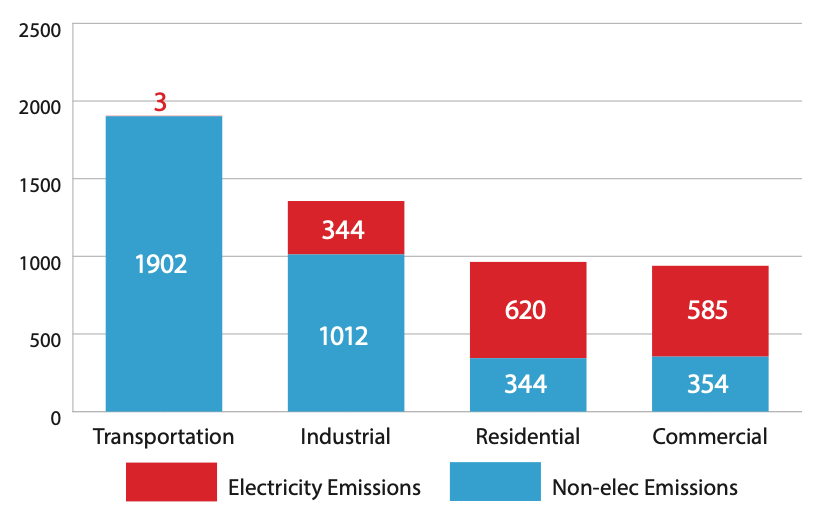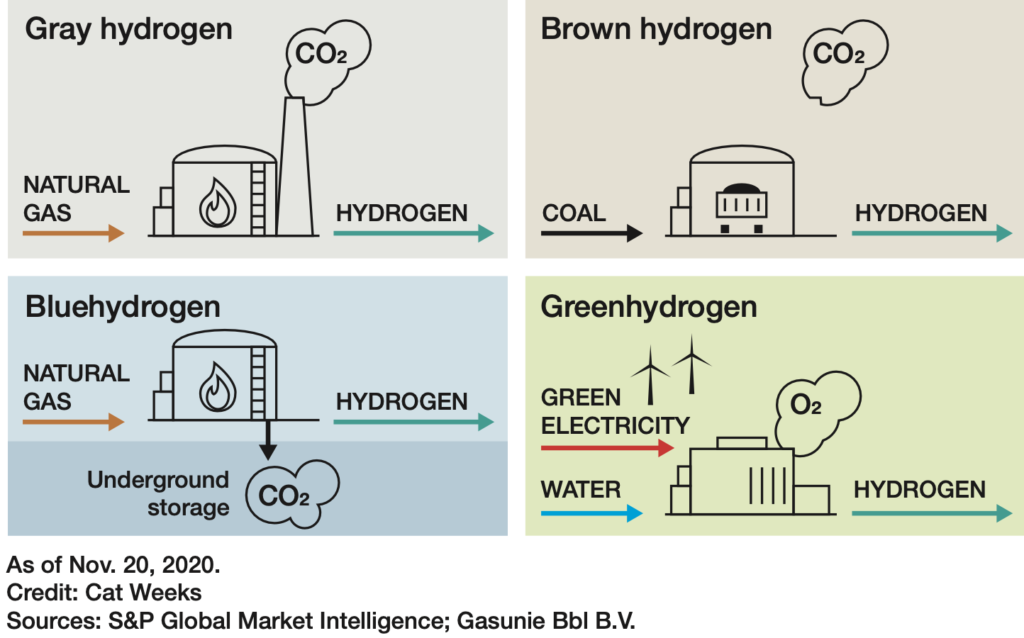SUSTAINABILITY INSIGHTS
Framing the U.S. sustainable energy challenge of the next 20 years
The United States is not alone in facing the significant challenge of moving toward more sustainable choices to fuel our economy. Progress has been made, but there is much more to be done if we are to fully address the impact of man- made emissions on climate change. It will touch every aspect of everyday life from how we heat our homes, how we make the basic products and materials we use, and how we transport those goods and ourselves around the world. Our most recent Insights piece highlights some of the key areas we expect to be focal points in the coming decades.
U.S. Contribution to Global Greenhouse Gas Emissions
Greenhouse gases absorb infrared radiation, thereby trapping heat in the atmosphere and making the planet warmer. The largest man-made contributions to atmospheric concentrations of GHG are carbon dioxide (CO2), methane (CH4), nitrous oxide (N2O) and several other fluorinated gases. In the United States, 2019 total gross greenhouse gas emissions were 6,557 million metric tons of carbon dioxide equivalent (MMT CO2 Eq) ), about 12% of the global total, and over 90% of those emissions were from CO2 and CH4. (source: EPA GHG inventory)


The Role of Power Generation
Reducing CO2 emissions from the generation of electricity has been part of the national discussion for the last twenty years. The first state level Renewable Portfolio Standard, dictating a certain percent of electricity consumption must be from renewable sources, was implemented in 2000. Today, thirty-one states have RPS in place and many states are increasing the overall percentage of renewables over time. In fact, thirteen states have adopted either 100% renewable or clean energy (includes nuclear) goals by 2050 (source: Clean Energy States Alliance)
And these efforts are making a difference. The total percentage of electricity generated from renewable sources has increased from about 7% to 20% since 2000. State level RPS goals are recognized as having driven between half and two thirds of the new solar and wind installation during this period. While total power consumption increased by 7%, CO2 emission from the sector are down 12%, meaning the carbon intensity per kWh of generation has actually reduced by 16% over this time period.
Looking to the future, state level mandates are expected to drive an incremental need for 372 Twh of annual renewable generation by 2040. That means without any Federal Renewable Portfolio Standard, which is a possibility, the current state goals plus existing nuclear generation has the U.S on a path to the majority of all power generation coming from emission free sources. It doesn’t fully address the challenge and there is more that can be done, but it is a better picture than other sectors.
Stubborn De-carbonization
While progress is being made in power generation, the stark reality is that two thirds of man-made U.S. GHG emissions do not come from the generation of electricity. These other sectors and sources are much harder to address and will require wider adoption of existing solutions and continued advances in new technologies.

The de-carbonization of transportation fuels and fuel used in space heating or process applications is the biggest single opportunity we have over the next twenty years.
Transportation Fuels

California was the first state to pass a Low Carbon Fuel Standard in 2010, mandating a 20% reduction in the Carbon Intensity (measured in grams of CO2 equivalent per Megajoule of energy) of transportation fuels produced and sold in the state. Oregon implemented a similar program in 2015 and Washington just recently passed a law establishing their LCFS, expected to be implemented in 2022. At least six other U.S. states currently have bills under consideration to do the same. Could Low Carbon Fuel Standards become the next Renewable Portfolio Standards? Experience in the power sector has proven that state mandates can make a big difference and California has provided a very workable model of how to decrease the carbon intensity of transportation fuel.
The United States has had a Federal Renewable Fuel Standard since the passage of the Clean Air Act in 2008. The program is administered by the EPA and mandates an annual Renewable Volume Obligation (RVO), which is the percent of total gasoline and diesel fuel sales that must come from renewable sources. For 2020, the RVO was about 11.5% of the total pool or 20 billion gallons. The RFS is widely recognized as driving the increased use of ethanol and biodiesel in the U.S., but has consistently fallen short of achieving its goals for cellulosic biofuels, such as renewable natural gas.
As we continue to make progress on de-carbonizing the power generation sector, electric vehicles will become a key lever. U.S. EV sales topped 320,000 units in 2020, but that is only 2.5% of total vehicle sales. That’s expected to be 1.8 million units by 2025 or 11% of vehicle sales. Even with increased adoption, it will still take another twenty years before the number of non-internal combustion engine vehicles on the road meets or exceeds ICE vehicles. (source: Bloomberg New Energy Finance) Progress in de-carbonizing transportation fuels will largely depend on speed and success of shifting away from internal combustion engine technology to electric vehicles, as well as how widespread state level low carbon fuel standards become which will promote the use of biodiesel, renewable diesel and renewable natural gas.
Space Heating and Thermal Process Energy
The next biggest opportunity, beyond transportation, is to reduce greenhouse gas emissions in the residential, commercial and industrial sector related to the combustion of fossil fuels for heating or process related energy. Total emissions here are just below those from the transportation sector and the paths to wide scale de-carbonization are challenging but not impossible. The biggest challenge is how we economically and practically move to lower carbon fuels or lower emitting energy conversion processes.
Renewable natural gas is a promising solution. Biogas is the result of a bio-mechanical process that emits methane when microbes digest organic material (landfilled waste, animal manure, wastewater). When biogas can be further processed to become renewable natural gas. RNG is chemically identical to natural gas and therefore has the advantage of being able to be used in our existing transportation systems and equipment without any further investment. Currently, RNG makes up less than one half of one percent of the total U.S. production of natural gas. However, RNG sources are increasing rapidly and could be closer to 3-6% at full potential. (source: American Gas Foundation: RNG Supply and Emission Reduction Assessment, 2020)

Green hydrogen is the holy grail, but remains a very costly process today. Costs will need to come down significantly, like we experienced with solar and wind, for hydrogen produced from renewable sources to become widely adopted. It will also require further investment in our distribution systems and end use applications for hydrogen to become a significant part of the solution. Several utilities are currently running pilot programs to determine the practical amount of hydrogen blending that can be supported in our existing gas systems and applications. A likely outcome here is some small percentage of hydrogen blending on a wide scale and dedicated bespoke hydrogen systems to support the most energy intensive uses.
There are other pieces to the puzzle, like building electrification and district energy systems powered by renewal sources. Reducing overall emissions here will require a multi-pronged approach.
The Big Picture
Reducing greenhouse gas emissions from energy consumption in the United States is a significant challenge. Certain sectors have made more progress than others.
In many cases, individual states are leading the way in mandating adoption of non or low emission fuels. Corporations are increasingly recognizing the need to reduce their own contribution with 90% of the S&P 500 companies currently publishing sustainability reports. Many companies are leading the way, adopting 100 renewable energy (RE 100) goals or science based emission reduction goals.
There are many solutions that are currently economical that need increased adoption. Other solutions are very promising but will require continued investment and research to become practical applications.
November 2021
